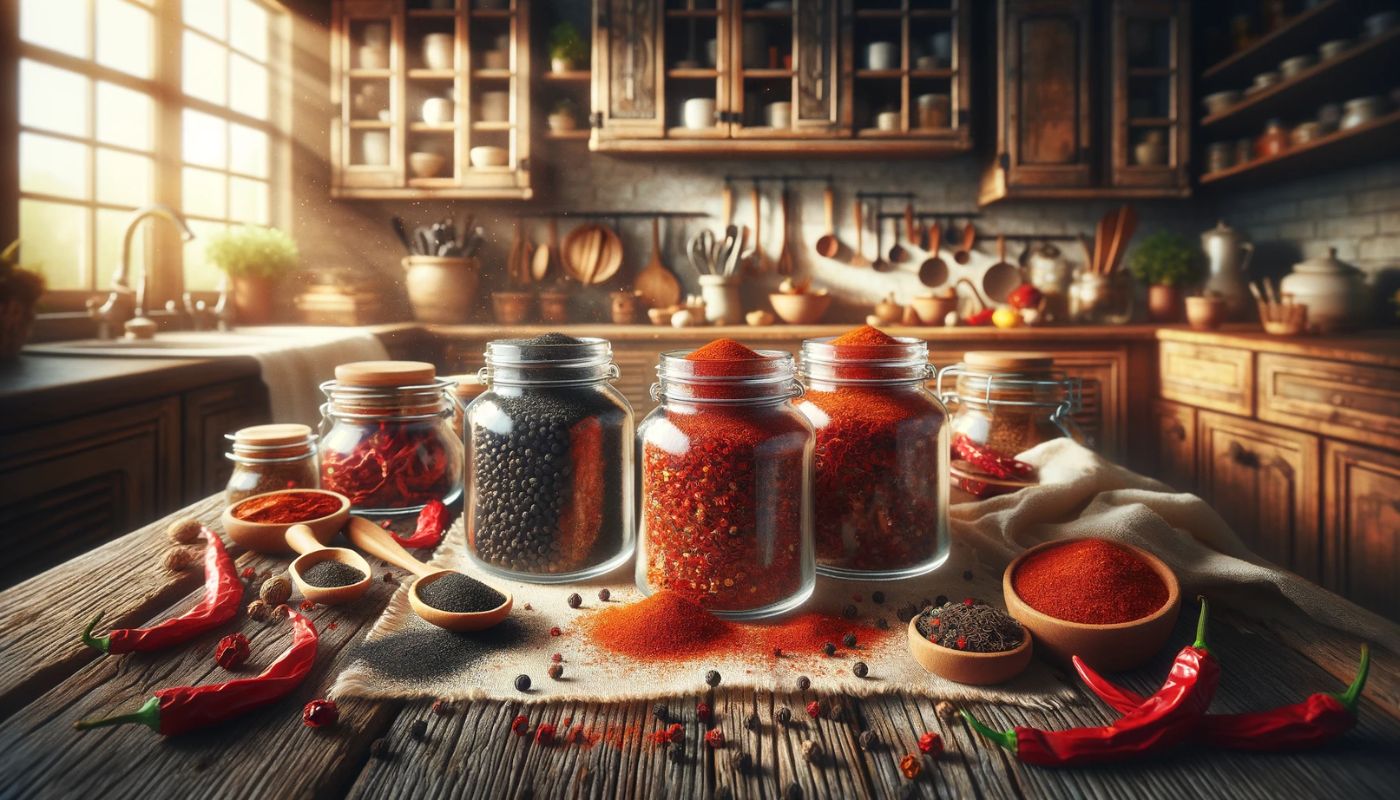Paprika and smoked paprika are two spices that are often used interchangeably in many recipes. While they may look similar, they have distinct differences in flavor and aroma.
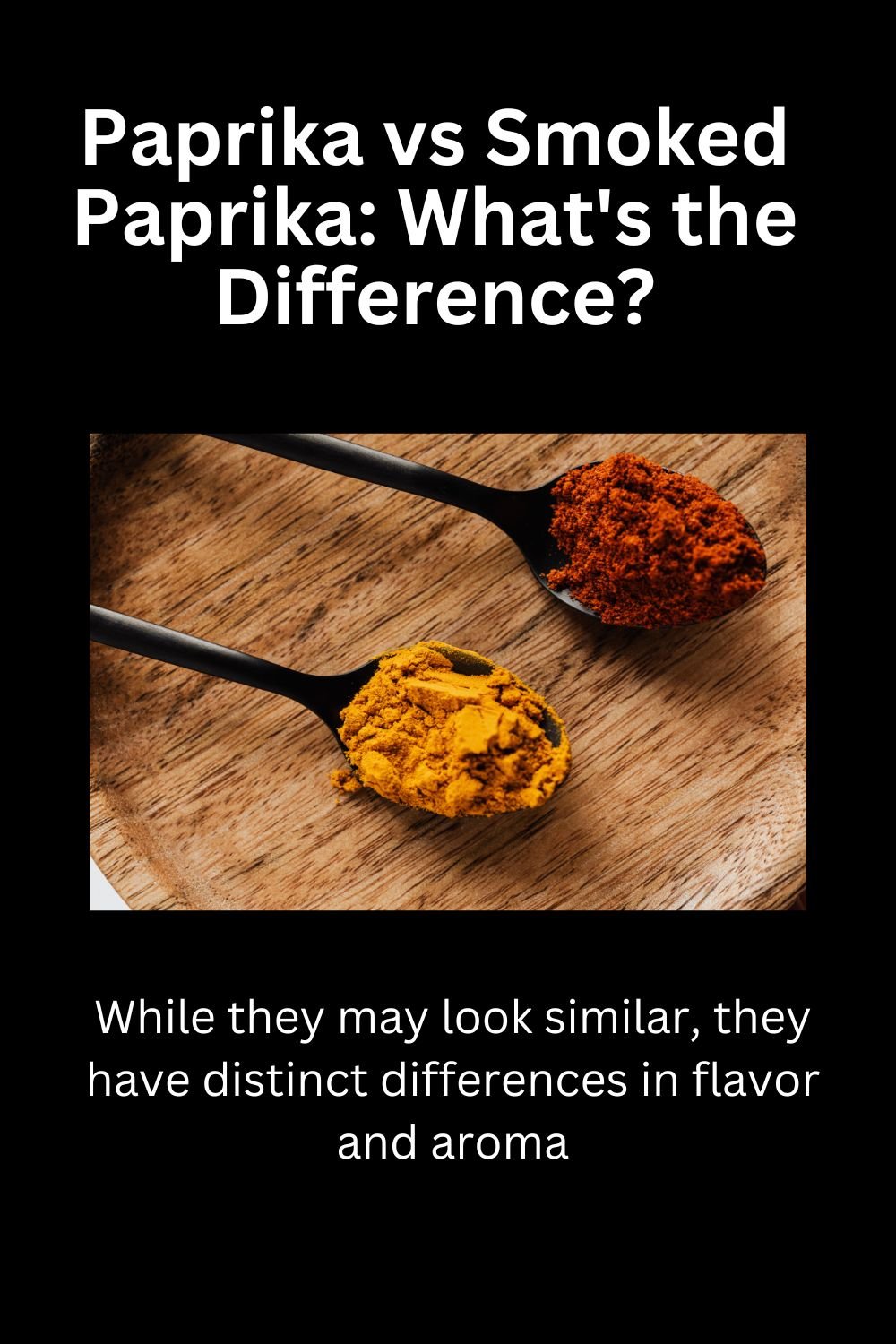
In this article, we will explore the differences between paprika and smoked paprika and how they are used in cooking.
Paprika is a spice made from dried and ground sweet peppers, typically from the Capsicum annuum family. It is commonly used in many cuisines, including Spanish, Hungarian, and Moroccan.
Paprika is known for its vibrant red color and mild, slightly sweet flavor. On the other hand, smoked paprika, also known as pimentón, is made from smoked and dried peppers. This gives it a distinctive smoky flavor and aroma that sets it apart from regular paprika.
Key Takeaways
- Paprika and smoked paprika are two distinct spices with different flavor profiles.
- Paprika is made from dried and ground sweet peppers and has a mild, slightly sweet flavor.
- Smoked paprika is made from smoked and dried peppers, giving it a distinct smoky flavor and aroma.
Defining Paprika
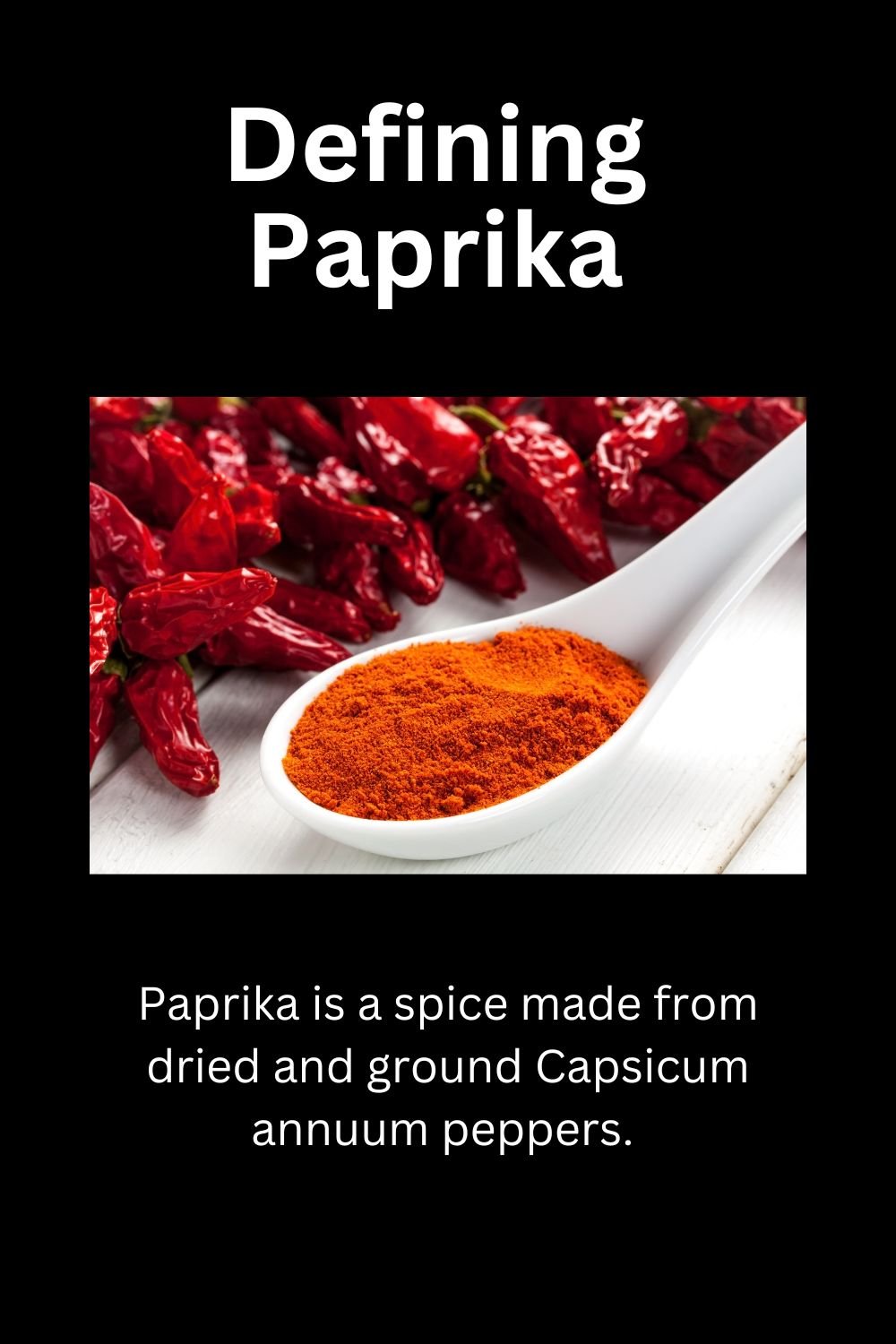
Origins and History
Paprika is a spice made from dried and ground Capsicum annuum peppers. These peppers are native to the Americas, but were brought to Europe by Christopher Columbus in the late 15th century.
The first recorded use of paprika in Europe was in Spain in the early 16th century, where it was used as a coloring agent for food.
Over time, paprika became a popular spice in Hungary, where it is still widely used today. Hungarian paprika is known for its bright red color and sweet flavor and is often used in traditional Hungarian dishes such as goulash and paprikash.
Cultivation and Production
Paprika peppers are typically grown in warm, dry climates, and are harvested when they are ripe and red. The peppers are then dried and ground into a fine powder, which can range in color from bright red to brownish-red.
There are several different types of paprika, each with its own unique flavor and heat level. Some varieties are sweet and mild, while others are hot and spicy.
Smoked paprika, also known as pimentón, is made by smoking the peppers before they are dried and ground. This gives it a smoky flavor that is popular in Spanish cuisine.
Defining Smoked Paprika
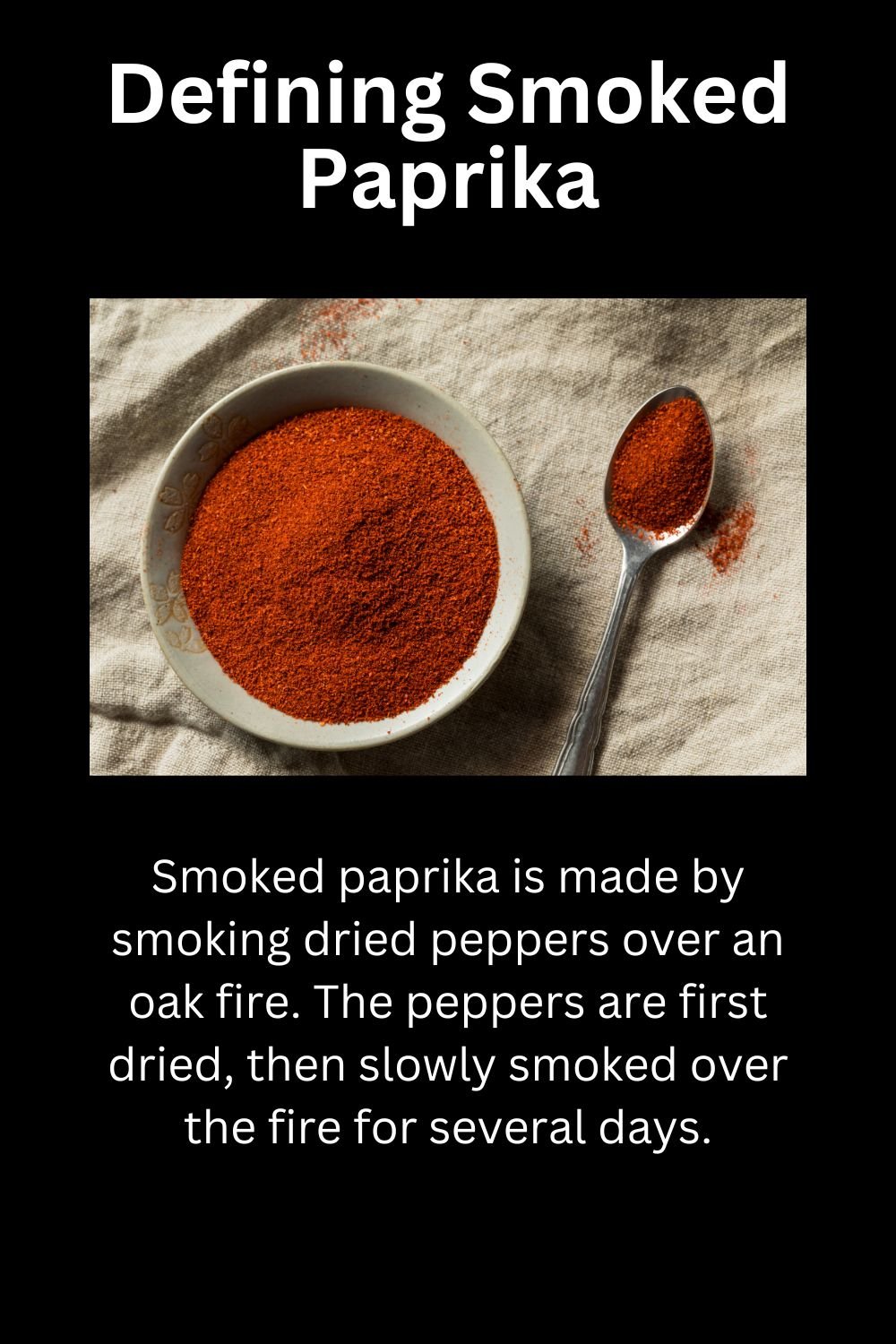
Smoking Process
Smoked paprika is made by smoking dried peppers over an oak fire. The peppers are first dried, then slowly smoked over the fire for several days.
The smoking process gives the paprika a distinct smoky flavor and aroma that sets it apart from regular paprika. The longer the peppers are smoked, the stronger the smoky flavor will be.
Varieties of Smoked Paprika
There are several varieties of smoked paprika, each with its own unique flavor profile. Some of the most common varieties include:
- Sweet smoked paprika: This variety has a mild smoky flavor and is often used in dishes where a subtle smoky flavor is desired.
- Hot smoked paprika: This variety has a stronger smoky flavor and a spicy kick. It’s often used in dishes where a bold, smoky flavor is desired.
- Bittersweet smoked paprika: This variety has a smoky, slightly bitter flavor and is often used in dishes where a complex flavor profile is desired.
In addition to these varieties, there are also regional variations of smoked paprika, such as Spanish smoked paprika, which is made from a specific type of pepper and has a unique flavor profile.
Culinary Uses
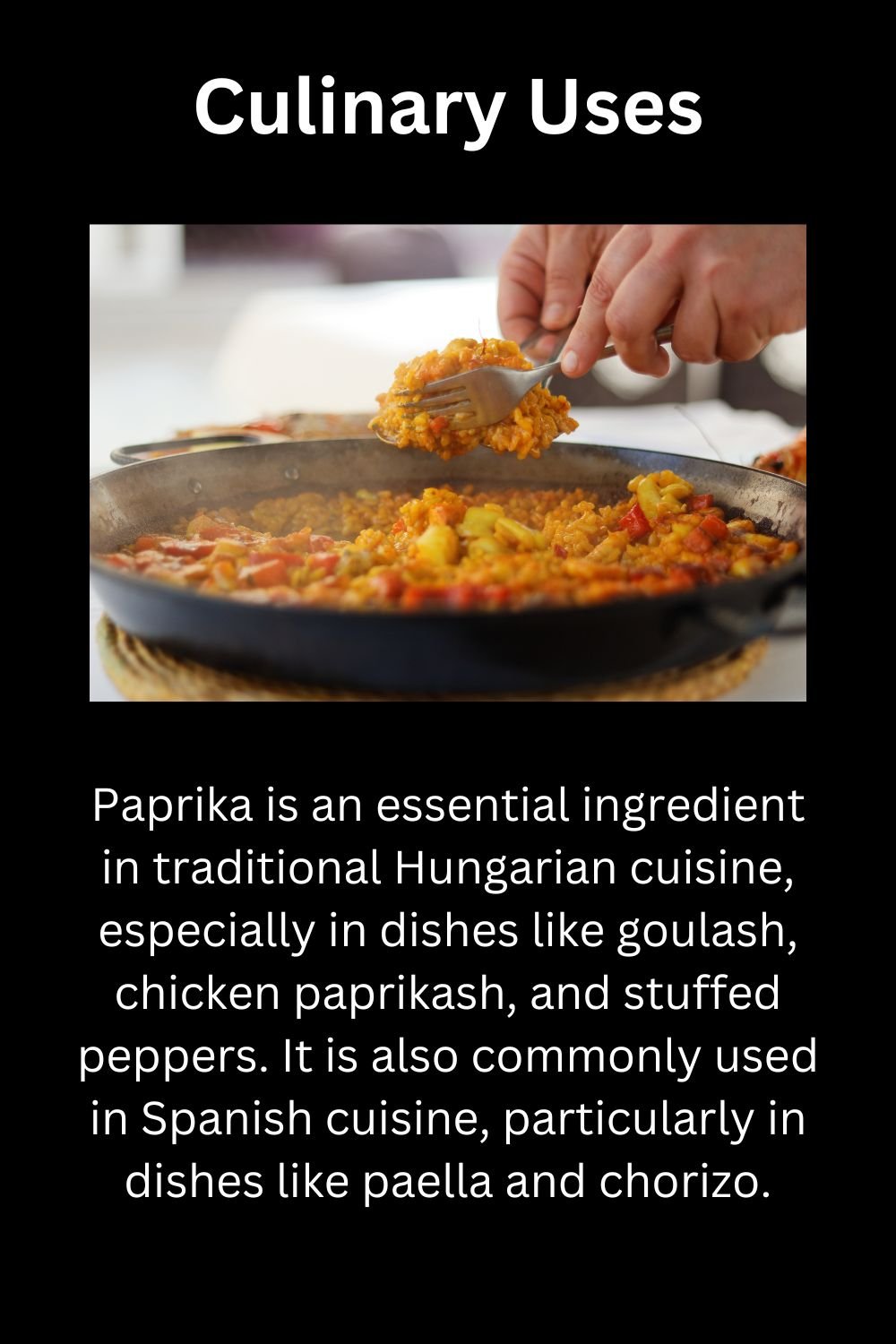
Traditional Dishes
Paprika is an essential ingredient in traditional Hungarian cuisine, especially in dishes like goulash, chicken paprikash, and stuffed peppers. It is also commonly used in Spanish cuisine, particularly in dishes like paella and chorizo.
Paprika adds a sweet and mild flavor to these dishes and gives them a vibrant red color.
Smoked paprika, on the other hand, is a staple in Spanish cuisine, where it is known as pimentón. It is commonly used in dishes like patatas bravas, grilled meats, and seafood.
Smoked paprika adds a smoky and slightly spicy flavor to these dishes, as well as a deep red color.
Modern Cuisine Applications
Paprika can be used in a variety of modern cuisine applications. It can be used to add flavor and color to dishes like roasted vegetables, soups, and stews. It can also be used as a seasoning for meat and poultry dishes.
Smoked paprika is also versatile and can be used in many modern cuisine applications. It can be added to marinades for meat and poultry, used to flavor dips and spreads, or sprinkled over roasted vegetables.
Its smoky flavor pairs well with grilled meats and seafood.
Flavor Profiles
Taste of Paprika
Paprika is a spice made from dried and ground peppers. It has a slightly sweet and mild taste, with a subtle bitterness that adds depth to dishes.
Paprika is often used to add color and flavor to dishes such as stews, soups, and roasted meats. It has a bright red color and a mild heat that ranges from sweet to slightly spicy.
Paprika is available in different varieties, including sweet, hot, and smoked. The sweet variety is the mildest and is often used in dishes where color is important, such as deviled eggs and potato salad.
The hot variety has a stronger flavor and is often used in dishes that require a bit of heat, such as chili and tacos.
Taste of Smoked Paprika
Smoked paprika, also known as pimentón, is made from peppers that are smoked over oak wood before being ground into a powder. This process gives the spice a rich, smoky flavor that is often described as “campfire-like.”
Smoked paprika is available in different varieties, including sweet, hot, and bittersweet.
- The sweet variety has a mild smoky flavor and is often used in dishes such as roasted vegetables and grilled meats.
- The hot variety has a stronger smoky flavor and is often used in dishes such as paella and chorizo.
- The bittersweet variety has a more intense smoky flavor and is often used in dishes such as smoked paprika aioli and smoked paprika hummus.
Nutritional Comparison
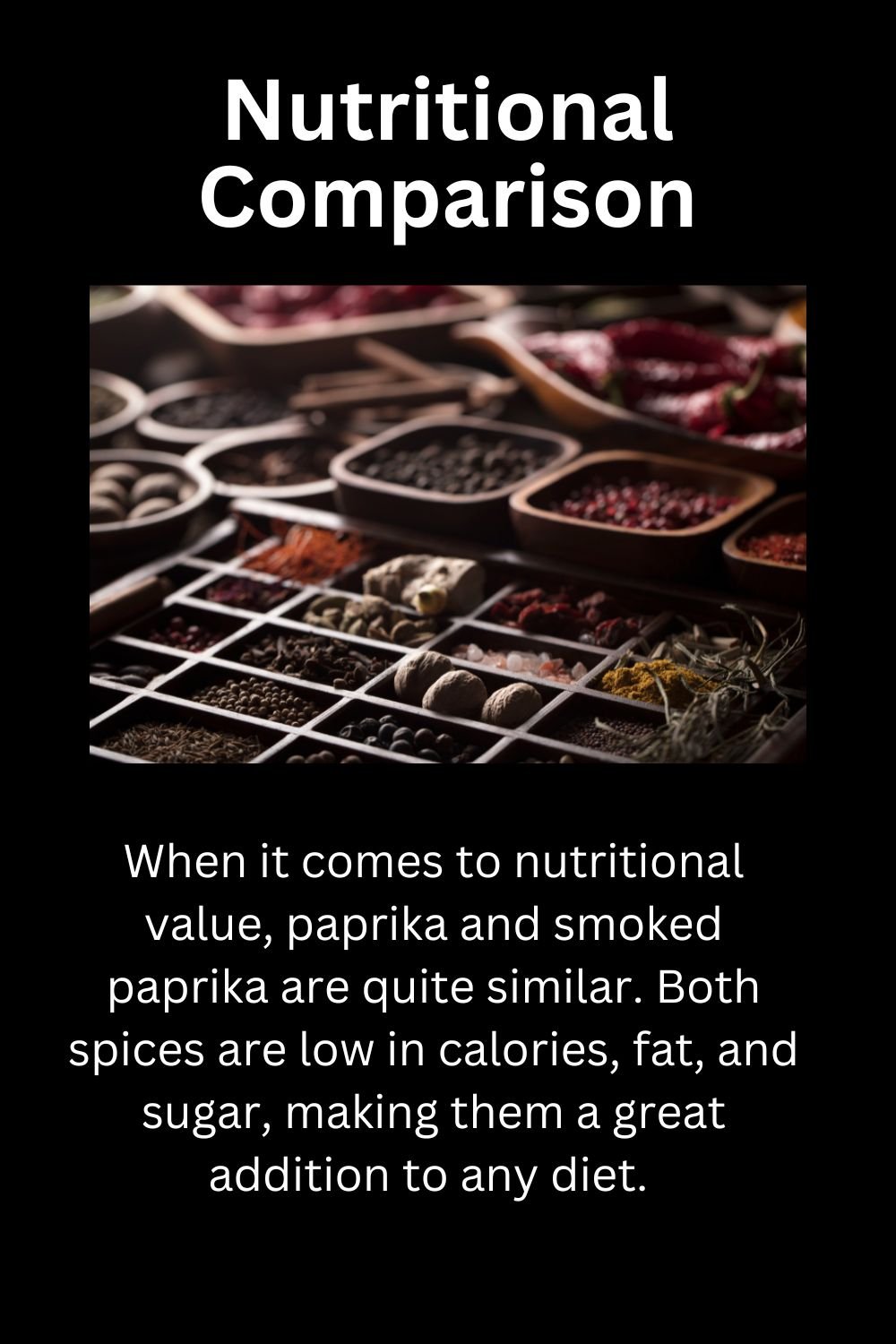
When it comes to nutritional value, paprika and smoked paprika are quite similar. Both spices are low in calories, fat, and sugar, making them a great addition to any diet. However, there are some differences in their nutrient composition.
Paprika is a good source of vitamin A, which is essential for maintaining healthy vision, skin, and immune function. One teaspoon of paprika contains about 6% of the recommended daily intake of vitamin A.
It also contains small amounts of other vitamins and minerals, such as vitamin E, vitamin B6, and iron.
Smoked paprika, on the other hand, has a slightly different nutrient profile. It contains more vitamin E than regular paprika, which is a powerful antioxidant that helps protect cells from damage.
It also has a smoky flavor that can add depth to dishes without adding extra calories or fat.
In terms of macronutrients, both paprika and smoked paprika are low in calories and fat. One teaspoon of either spice contains only about 6 calories and less than 1 gram of fat.
They are also low in sugar and carbohydrates, making them a great choice for people following a low-carb or ketogenic diet.
Health Benefits
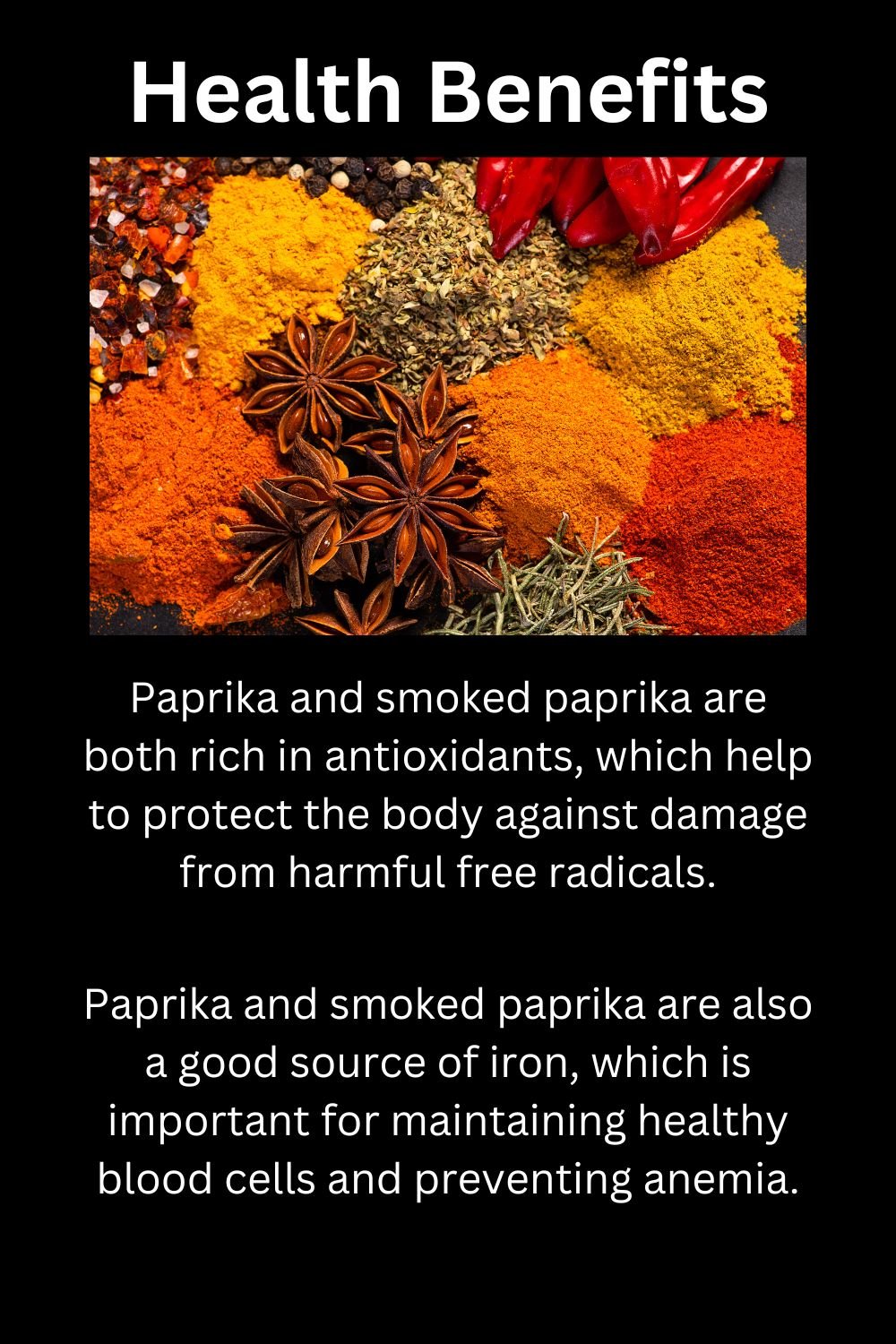
Antioxidant Properties
Paprika and smoked paprika are both rich in antioxidants, which help to protect the body against damage from harmful free radicals. Free radicals are unstable molecules that can damage cells and contribute to the development of chronic diseases such as cancer, heart disease, and Alzheimer’s disease.
Studies have shown that the antioxidants in paprika and smoked paprika can help to reduce inflammation in the body, which is a key factor in many chronic diseases. In addition, these antioxidants may help to improve blood sugar control and reduce the risk of type 2 diabetes.
Dietary Significance
Both paprika and smoked paprika are low in calories and fat, making them a healthy addition to any diet. They are also a good source of vitamin A, which is important for maintaining healthy skin, vision, and immune function.
Paprika and smoked paprika are also a good source of iron, which is important for maintaining healthy blood cells and preventing anemia. In addition, they contain small amounts of other important nutrients such as vitamin E, vitamin B6, and potassium.
Cooking Tips
Substituting Spices
When substituting paprika with smoked paprika, keep in mind that the latter has a stronger, smokier flavor.
If you’re looking to add a smoky flavor to a dish that calls for paprika, smoked paprika is a great option. However, if you’re looking for a milder flavor, you may want to mix paprika with a small amount of smoked paprika.
On the other hand, if a recipe calls for smoked paprika and you don’t have any on hand, you can substitute it with regular paprika mixed with a small amount of liquid smoke.
Keep in mind that the flavor may not be exactly the same, but it will still add a smoky element to the dish.
Storage Recommendations
Both paprika and smoked paprika should be stored in a cool, dry place away from direct sunlight.
It’s best to store them in airtight containers to prevent moisture from getting in, which can cause the spices to clump together and lose their flavor.
If stored properly, paprika can last up to 6 months, while smoked paprika can last up to a year.
It’s a good idea to label your containers with the date you purchased the spice to keep track of how long it’s been in your pantry.
Global Influence
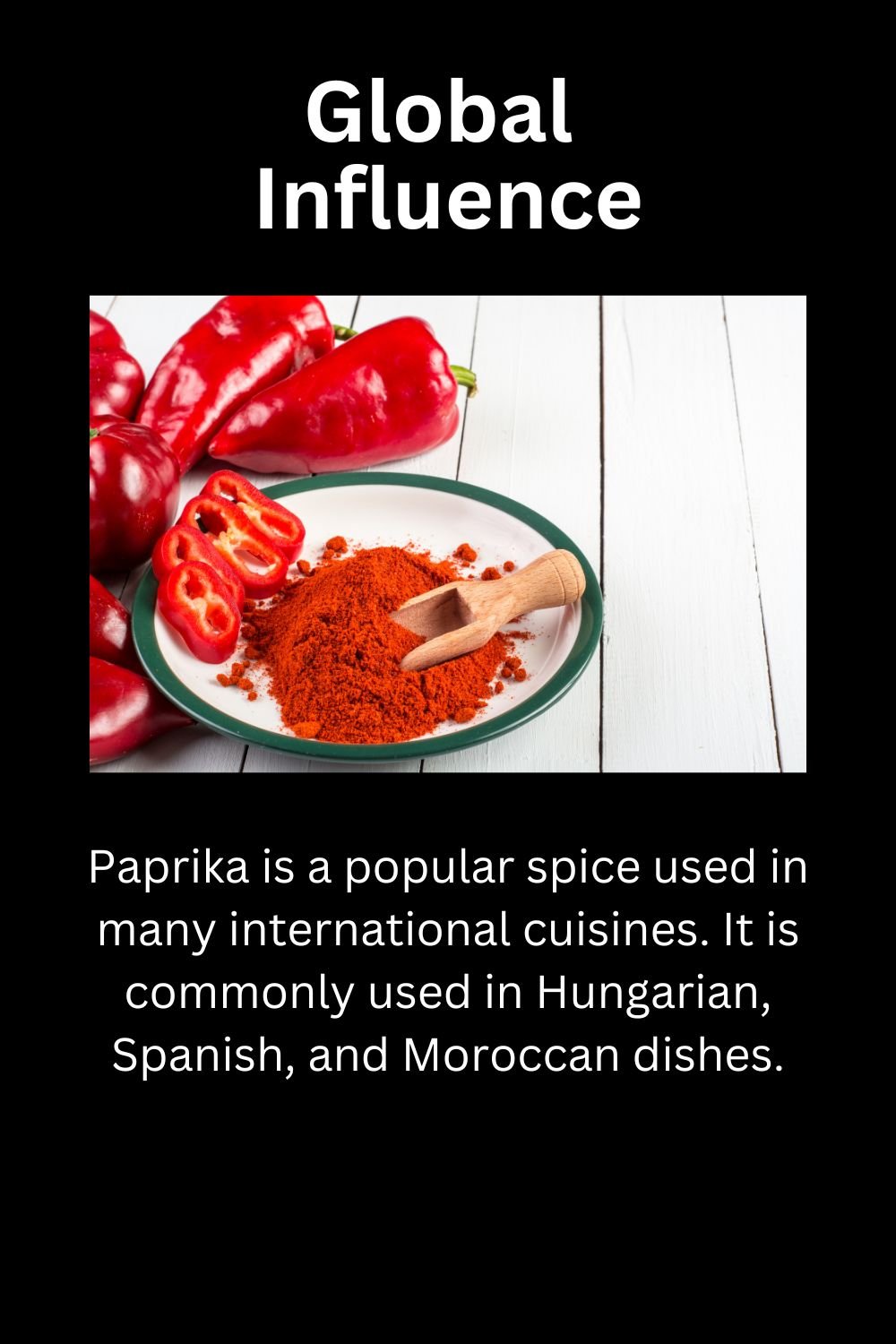
Paprika in International Cuisines
Paprika is a popular spice used in many international cuisines. It is commonly used in Hungarian, Spanish, and Moroccan dishes.
In Hungary, paprika is a national spice and is used in many traditional dishes such as goulash and chicken paprikash.
Spanish cuisine also heavily relies on paprika, with dishes like chorizo and paella featuring the spice. Moroccan cuisine uses paprika in their spice blends, such as ras el hanout, which is used in many meat and vegetable dishes.
Paprika is also used in other international cuisines, such as Indian and Turkish.
In Indian cuisine, paprika is used in spice blends and curries. Turkish cuisine uses paprika in dishes like kebabs and stews.
Smoked Paprika’s Growing Popularity
Smoked paprika, also known as pimentón, is a type of paprika that has been smoked over oak wood. It has a distinct smoky flavor and is becoming increasingly popular in international cuisines.
It is commonly used in Spanish dishes, such as patatas bravas and chorizo, and is also used in Mexican cuisine.
Smoked paprika is also used in American cuisine, particularly in barbecue rubs and sauces. It adds a smoky flavor to meats and vegetables.
It is also commonly used in vegan and vegetarian dishes to add a meaty, smoky flavor.
Buying Guide

When buying paprika, there are a few things to keep in mind to ensure you get the best quality product. Here are some key factors to consider:
Quality Indicators
The quality of paprika can vary depending on factors such as the type of pepper used, the region it was grown in, and the processing method.
Look for paprika that has a bright, vibrant color and a rich, smoky aroma. The flavor should be complex, with a balance of sweetness, heat, and smokiness.
To ensure you’re getting a high-quality product, look for paprika that is labeled as “sweet” or “hot” rather than simply “paprika.” This will give you a better idea of the flavor profile you can expect.
You may also want to consider buying paprika that is labeled as “smoked” for a more intense, smoky flavor.
Labeling and Authenticity
When buying paprika, pay attention to the labeling and authenticity of the product.
Look for paprika that is labeled with the country of origin, as this can give you an idea of the quality and flavor profile of the product.
Hungarian paprika, for example, is known for its rich, sweet flavor and vibrant color.
You may also want to look for paprika that is certified as authentic by a reputable organization. This can help ensure that you’re getting a high-quality product that is made using traditional methods and ingredients.
Home Preparation
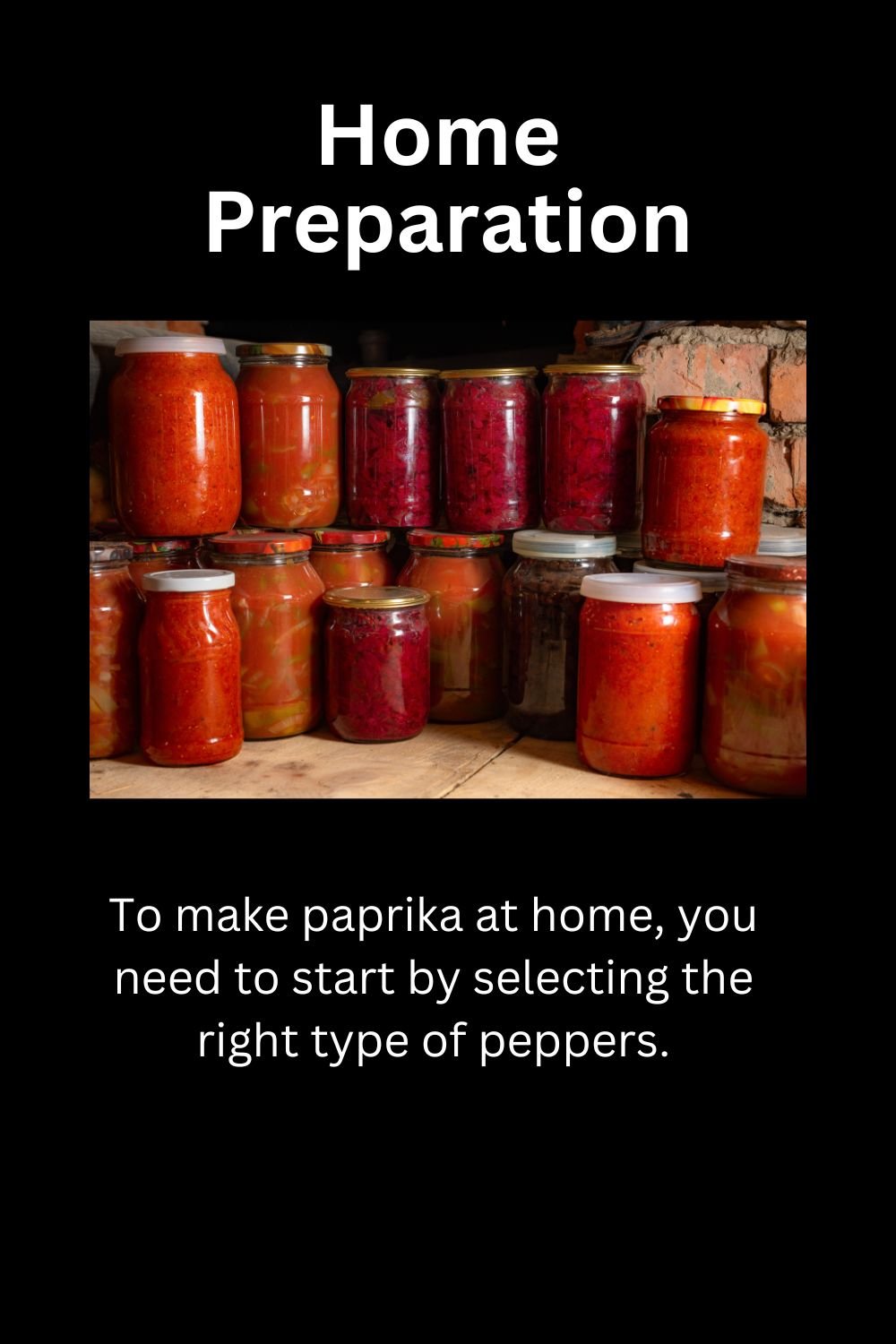
Making Paprika at Home
To make paprika at home, you need to start by selecting the right type of peppers. Hungarian wax peppers, also known as banana peppers, are the most commonly used peppers for making paprika.
Once the peppers have been selected, they need to be washed and dried thoroughly. The seeds should be removed, and the peppers should be sliced into thin strips.
Next, the peppers need to be dried. This can be done either in the sun or in a dehydrator.
If drying in the sun, the pepper strips should be laid out on a flat surface and turned regularly to ensure even drying. Once the peppers are completely dry, they can be ground into a fine powder using a spice grinder or mortar and pestle.
DIY Smoked Paprika Techniques
Smoked paprika can be made at home by smoking dried peppers over a low heat.
To do this, place the dried pepper strips in a smoker and leave them to smoke for several hours. The longer the peppers are smoked, the more intense the smoky flavor will be.
Another technique for making smoked paprika is to smoke the dried peppers over a wood fire.
This can be done by placing the peppers on a wire rack and suspending it over the fire. The peppers should be turned regularly to ensure even smoking. Once the peppers are smoked, they can be ground into a fine powder using a spice grinder or mortar and pestle.
Both homemade paprika and smoked paprika can be stored in an airtight container in a cool, dry place for up to six months. It is recommended to make small batches at a time to ensure the freshness of the spice.
Frequently Asked Questions
What is the taste difference between paprika and smoked paprika?
Paprika has a sweet, mild flavor, while smoked paprika has a smoky, earthy taste. The smokiness comes from the drying process, where the peppers are smoked before being ground into a powder.
What can be used as a substitute for smoked paprika?
If you don’t have smoked paprika, you can use regular paprika mixed with a bit of liquid smoke or chipotle powder for a similar smoky flavor.
How do smoked paprika and Hungarian paprika differ?
Smoked paprika can be made with any type of pepper, while Hungarian paprika is made specifically from Hungarian peppers.
Hungarian paprika also comes in different varieties, ranging from sweet to hot, while smoked paprika is generally mild.
In recipes, when paprika is called for, does it refer to sweet or smoked?
Unless otherwise specified, recipes usually refer to sweet paprika. If the recipe calls for smoked paprika, it will usually specify “smoked” or “Spanish smoked” paprika.
Is there a nutritional difference between paprika and smoked paprika?
Both sweet and smoked paprika are low in calories and fat and are a good source of vitamin A. However, smoked paprika may have slightly more antioxidants due to the smoking process.
Are there distinct uses for smoked paprika compared to regular paprika in cooking?
Smoked paprika is great for adding a smoky flavor to dishes like chili, barbecue sauce, and roasted vegetables.
Regular paprika is often used for color and flavor in dishes like deviled eggs, chicken paprikash, and goulash.
